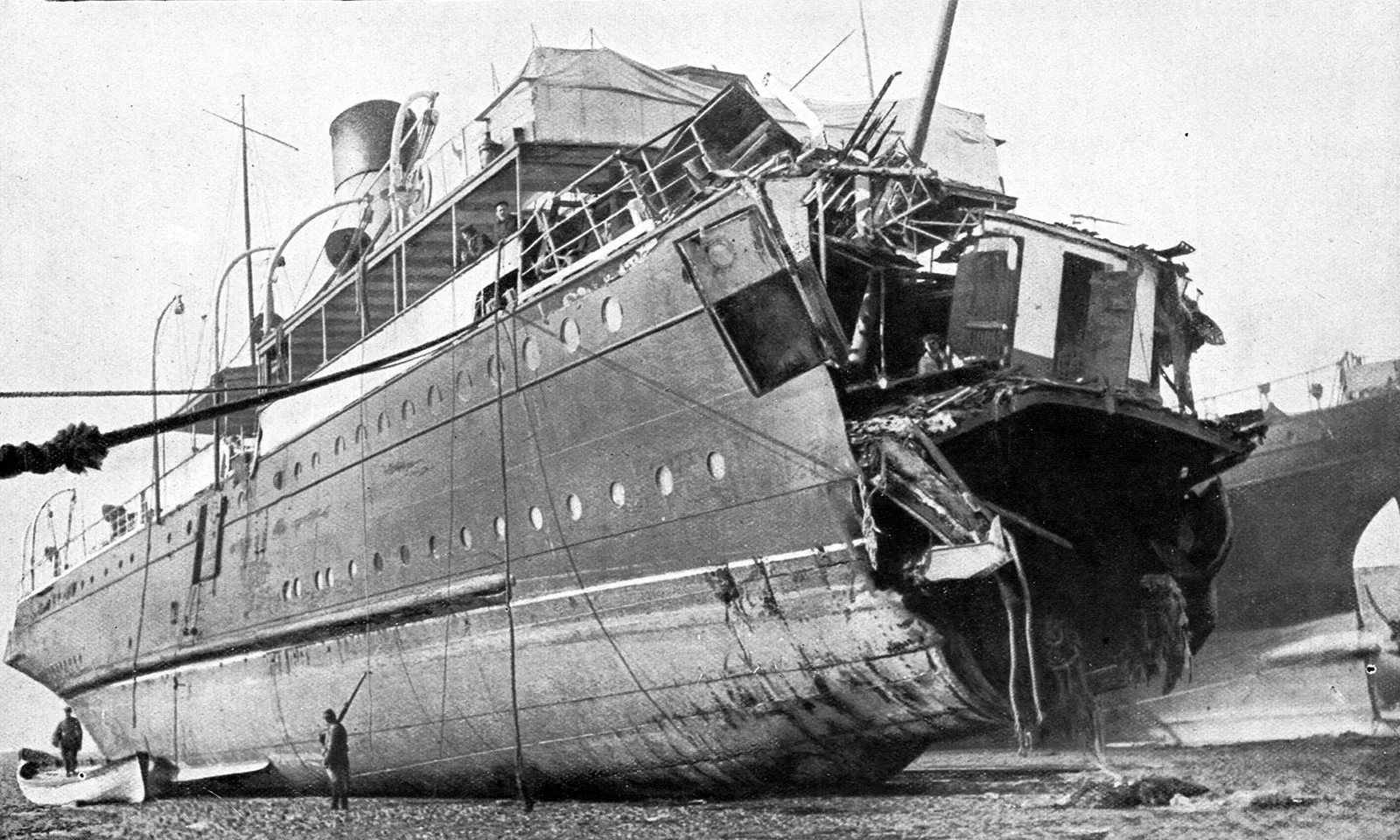Navigating Neutrality in a World at War
To avoid the horrors of World War I, the United States walked a diplomatic tightrope. The Arabic Pledge and the Sussex Pledge stand out as attempts to maintain American neutrality. However, these pledges, born from tragedy and desperation, ultimately failed, drawing the nation into the devastating conflict engulfing Europe.
The Arabic Pledge: A Promise Forged in Crisis
The sinking of the British passenger liner Arabic by a German submarine in 1915 sent shockwaves through the international community. The loss of American lives fueled outrage, placing immense pressure on Germany to appease the United States and avoid drawing the nation into the war.
Germany responded with the Arabic Pledge, promising to exercise greater caution and refrain from sinking passenger ships without warning, allowing civilians to evacuate. This pledge offered a brief respite from escalating tensions, but its ambiguity proved problematic. The agreement lacked clear stipulations regarding attacks on merchant ships, vessels vital for wartime supplies. This critical loophole would resurface with dire consequences.
The Sussex Pledge: A More Desperate Plea for Peace
In 1916, the German attack on the unarmed French passenger ferry Sussex once again brought the U.S. to the brink of war. President Woodrow Wilson, steadfast in his pursuit of neutrality, issued a stern ultimatum to Germany: cease attacks on passenger ships or face the consequences of American intervention.
The resulting Sussex Pledge, a more comprehensive agreement, extended protections to merchant ships. It seemed like a victory for peace, but this pledge came at a cost for Germany. By placing limitations on their naval operations, it significantly hindered their submarine warfare strategy—a promise that seemed increasingly difficult to keep as the war raged on.
Comparing the Pledges: Two Sides of the Same Coin
Here’s a simple breakdown of the two pledges:
| Feature | Arabic Pledge | Sussex Pledge |
|---|---|---|
| What Sparked It | Sinking of the Arabic | Attack on the Sussex |
| What it Covered | Passenger ships only | Both passenger and merchant ships |
| How Specific Was it | Less detailed, open to interpretation | More detailed and specific |
| What Impact Did it Have | Reduced tensions for a short time | Postponed U.S. entry into World War I |
The Pledges Unravel: A Return to Unrestricted Warfare
By 1917, the tenuous peace held together by these pledges disintegrated. Feeling the mounting pressures of the war and sensing a chance for swift victory, Germany made a fateful decision. They resumed unrestricted submarine warfare, gambling that the potential rewards outweighed the risk of American intervention.
This decision, compounded by the revelation of the Zimmermann Telegram – a secret message exposing Germany’s attempt to incite Mexico into attacking the U.S. – dramatically shifted American public opinion. Neutrality lost its appeal as outrage swept the nation. The United States officially entered World War I in April 1917.
A Lasting Impact: Broken Promises and the Shift in American Foreign Policy
The broken Arabic and Sussex Pledges represent more than historical footnotes. They profoundly impacted America’s perception of its role on the world stage. The sense of betrayal fueled a shift away from isolationism toward a more active involvement in global affairs. The experience of World War I, along with the events that precipitated it, would shape American foreign policy for decades to come.
Unlocking the Arabic and Sussex Pledges: A Deeper Dive
What did the Arabic and Sussex pledges refer to?
Imagine the world on the precipice of a global conflict – that was the reality of the early 20th century. Germany, engaged in World War I, employed a strategy of unrestricted submarine warfare, targeting ships regardless of their nationality. This tactic directly threatened the United States, a nation striving to remain neutral. The Arabic and Sussex Pledges emerged as desperate attempts to prevent the situation from escalating into a full-blown international crisis.
The Arabic Pledge, a direct response to the sinking of the British passenger liner Arabic in 1915 (resulting in the loss of American lives), served as Germany’s assurance to curtail attacks on passenger ships without warning. This concession aimed to alleviate pressure from the U.S. and prevent its entry into the war.
The Sussex Pledge, a year later in 1916, came after a German submarine attacked the Sussex, a French passenger ferry. This time, Germany went further, expanding the pledge to include merchant ships as well. However, this apparent concession masked a strategic dilemma for Germany: it restricted their naval operations, potentially hindering their war effort.
For a brief period, these pledges provided a semblance of stability, but their effectiveness was limited. In 1917, Germany resumed unrestricted submarine warfare, effectively breaking both agreements. This decision, coupled with the Zimmermann Telegram scandal, proved to be the tipping point for the United States. Public opinion, once largely in favor of neutrality, swung decisively towards intervention.
The Arabic and Sussex Pledges, while ultimately unsuccessful in preventing war, offer crucial insights into the complexities of international diplomacy during wartime. They underscore the fragility of neutrality, the high stakes of strategic decision-making, and the devastating consequences of broken promises on the world stage.
Why Was the Sussex Pledge Broken?
The Sussex Pledge, a pivotal agreement between Germany and the United States in 1916, held the potential to keep America out of World War I. However, Germany ultimately reneged on its promise, a decision with profound historical consequences.
Several factors contributed to Germany’s fateful decision:
1. The Allure of Unrestricted Submarine Warfare: Germany believed that cutting off supply lines to Great Britain, a key Allied power, was crucial for victory. Unrestricted submarine warfare, despite its controversial nature, offered a potential path to crippling the British war effort.
2. A Calculated Gamble: German leadership, confident in their military capabilities, miscalculated the resolve of the United States. They assumed they could achieve a decisive victory against Britain before the U.S. could mobilize for war, even if it meant risking American intervention.
3. Internal Pressures: Within Germany, powerful voices advocated for unrestricted submarine warfare. The German Navy, eager to fully utilize its U-boat fleet, exerted significant pressure on the government. Additionally, public opinion, fueled by wartime propaganda and a desire for victory, increasingly favored aggressive tactics.
In January of 1917, succumbing to these pressures and convinced of the strategic necessity, Germany resumed unrestricted submarine warfare. This decision, a gamble that backfired spectacularly, proved to be a turning point in the war. The breaking of the Sussex Pledge, coupled with the outrage sparked by the Zimmermann Telegram, pushed the United States firmly into the Allied camp.
The Sussex Pledge serves as a stark reminder that diplomatic agreements, even those forged with the best intentions, can crumble under the weight of strategic ambition and the pressures of war.
Demystifying the Sussex Pledge: A Closer Look
Imagine you’re in 1916, the world embroiled in the chaos of World War I. The U.S. is trying its best to stay neutral, but Germany’s submarine warfare tactics keep making that tricky. Then comes the Sussex incident, where a German U-boat attacks an unarmed French passenger ship, injuring several Americans. This event pushed tensions to a boiling point.
President Woodrow Wilson, facing public outcry and determined to avert war, issued Germany an ultimatum: stop attacking passenger ships without warning, or face the consequences. Germany, not quite ready to add the U.S. to its list of enemies, responded with the Sussex Pledge.
Here’s the gist of what Germany promised:
- No More Surprise Attacks on Passenger Ships: Passenger ships, carrying civilians, were considered off-limits for unprovoked attacks.
- Merchant Ships Get a Warning: Germany agreed to warn merchant ships before attacking, giving crews and passengers a chance to evacuate.
- Proof Before Sinking: Germany also pledged to verify if a merchant ship was carrying weapons before attacking, a concession to international maritime law.
This pledge brought a temporary lull in the conflict, but it was ultimately a fragile peace. Germany, feeling the strain of the war and believing in the effectiveness of their submarine warfare, eventually broke their promise in 1917. This, along with the Zimmermann Telegram controversy, fueled the U.S.’s decision to finally join the war on the side of the Allies.
The Sussex Pledge is a significant event in history. It shows how quickly diplomatic efforts can unravel during wartime and how even a glimmer of hope for peace can be extinguished by strategic calculations and the unpredictable nature of conflict.
Why the Sussex Pledge Backfired: A US Perspective
The Sussex Pledge, while seemingly offering a path to peace, was ultimately a flawed agreement that put the United States in a precarious position. Here’s why:
1. A Band-Aid Solution: The pledge addressed the symptoms – attacks on passenger ships – but not the underlying issue: Germany’s strategic reliance on unrestricted submarine warfare. It was only a matter of time before they felt compelled to resume these tactics.
2. A False Sense of Security: The temporary reprieve from attacks lulled the U.S. into a false sense of security, leading to a delay in military preparedness. When Germany inevitably broke the pledge, the U.S. was caught off guard.
3. A Blow to International Law: By accepting the pledge, the U.S. implicitly acknowledged Germany’s right to attack merchant ships, even if they followed certain rules. This undermined established international maritime law and set a dangerous precedent for future conflicts.
4. Limited Diplomatic Leverage: Before the Sussex Pledge, the U.S. held a stronger position in negotiations, with the credible threat of entering the war. The pledge, however, weakened their leverage. When Germany resumed unrestricted submarine warfare, the U.S. had fewer options other than direct military intervention.
In essence, the Sussex Pledge was a short-term fix that ultimately backfired. It delayed, but did not prevent, America’s entry into World War I, and arguably, left the nation in a weaker position when it finally joined the conflict. It serves as a cautionary tale about the limits of appeasement and the importance of carefully considering long-term consequences in international relations.
- Unlocking Francis Alexander Shields’ Finance Empire: A Comprehensive Biography - July 12, 2025
- Unveiling Francis Alexander Shields: A Business Legacy - July 12, 2025
- Francis Alexander Shields’ Business Career: A Comprehensive Overview - July 12, 2025















